Template:Sideicon
We all of us bear a touch of darkness, just as surely as we bear light. Much as with the twin sets of Crystals. And the darkened underworld that rests beneath your planet's brighter surface. But as long as there is darkness, so will there always be light.
Dualism is one of the most common plot themes of the Final Fantasy series. This is often a theme of contrast between two drastically different elements. It also tends to involve the cycles of these two contrasted elements, cycles which the protagonists' goal is often to break.
Appearances
Final Fantasy
Garland created a time loop when made a pact to live forever by having the Fiends of Chaos summon him 2000 years in the past when he is defeated by the Light Warriors. There, Garland sends the Fiends of Chaos to the present, continuing the loop. When the Light Warriors travel back in time, they kill the Fiends and confront Garland, who transforms into Chaos and is defeated. This act ultimately breaks the time loop.
Final Fantasy II
The Emperor's dark side goes to Hell when he is killed and takes it over, raising its capital, Pandaemonium, to Earth. As well, the Emperor's light side ascends to Heaven and enters Arubboth, Capital of Heaven. Firion and his allies kill the Dark Emperor, while Minwu and the spirits of other dead characters kill the Light Emperor, ensuring the Emperor is destroyed for good.
Final Fantasy III
The setting features a world of light and a world of darkness. Each world also has a group of heroes arise to save their world from being consumed by the opposing property. When Xande drains the Crystals of their power, he creates an imbalance between light and darkness. This causes the Cloud of Darkness to appear to return the universe to a state of nothingness. The Warriors of Light attempt to stop her, but are defeated. Through the aid of the Warriors of the Dark, the Warriors of Light overcome and destroy her.
Final Fantasy IV
The Blue Planet has two parallels: the Red Moon, and the Underworld. The surface world has four Crystals of Light, and the Underworld has four Crystals of Darkness. The Red Moon also has eight Crystals, four each of Light and Darkness. Cecil Harvey is a Dark Knight who becomes a Paladin by receiving the light-aligned power of his father Kluya. Golbez, Cecil's older brother, is aligned with darkness and uses powerful black magic to collect all eight Crystals in his quest for power. In the game's finale, Golbez uses a Crystal to attempt to subdue Zeromus, but fails as his heart is tainted with darkness. He thus passes the Crystal to Cecil, who uses his light to render Zeromus vulnerable and defeat him.
Final Fantasy V
Planet R was split in two to contain the power of the Void. Each world has a set of four Crystals, which are key to maintaining the worlds. When the warlock Exdeath escapes from his sealing, he destroys the Crystals, forcing the two worlds back together and unleashing the Void. The two generations of the Warriors of Dawn and Light combine their powers to destroy Exdeath and recreate the Crystals.
Final Fantasy VI
The War of the Magi 1000 years prior nearly destroyed the world. This conflict was caused by a war between espers and humans. In the present, the Gestahlian Empire is seeking espers to take over the world, but Terra Branford, a hybrid of an esper and a human, represents the hope that the two races could co-exist. Terra fights to defend the hopes of the orphans of Mobliz, who have given her life meaning. The antagonist Kefka Palazzo is an experimental Magitek Knight driven insane and power-hungry, who believes life is meaningless and that love and hope are illusions.
Final Fantasy VII
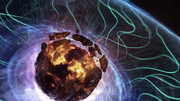
The battling forces of the Meteor and Holy.
The typical conflict between light and darkness is replaced by a conflict between nature and humanity, and science and magic. Sephiroth, representing the power of science as a genetic experiment of the Shinra Electric Power Company, uses the Black Materia to summon Meteor to ravage the planet. Aeris Gainsborough, last of the magical Cetra, stands in opposition to Sephiroth, representing nature. She uses the White Materia to summon Holy which can stop Meteor.
The dualism between Aeris and Sephiroth is clarified in The Reunion Files, where Tetsuya Nomura states "as long as Sephiroth exists, Aerith must exist". The Lifestream also serves as a cycle, as all living things, even plants, have spirit energy that comes from the planet. When someone dies, their spirit energy returns to the planet and their knowledge joins the collective. The Shinra are draining this spirit energy to produce Mako, and spirit energy is also the basis for the creation of Materia.
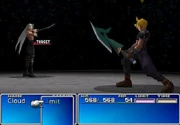
Cloud versus Sephiroth.
Sephiroth is also juxtaposed with Cloud Strife. There is a deliberate contrast between their sword types and hair styles. Cloud wanted to be a First Class SOLDIER hero like Sephiroth, and they both have the Mako eyes of a SOLDIER member. They both struggle with identity, and become willing to assume a new one to give their lives meaning and structure. They both go berserk at the revelation that they might not truly be the people they had identified as. Sephiroth can literally act his will through Cloud when Cloud is weakened, and the game's final, cinematic confrontation represents Cloud expunging Sephiroth's influence from him.
Crisis Core -Final Fantasy VII-
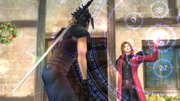
Zack and Genesis.
Zack Fair's quest to become a hero contrasts with the same quest Genesis Rhapsodos undertakes, but whereas the latter's feelings of entitlement to the moniker of "hero" lead to obsession and downfall, Zack's quest to "become a hero" has less to do with personal glory and more with making the world a better place. Zack's will to become a hero motivated him to think for himself and to be guided by his moral compass and sense of justice, whereas Genesis's obsession with becoming a hero drove him to challenge those he saw as hindrances and a need to prove himself as superior to others. Both joined SOLDIER inspired by stories of the hero First Class Sephiroth, striving to emulate him, and both fall from Shinra's graces after learning of the company's corrupt ways. In an inversion of a typical hero-villain story dynamic, Zack dies whereas Genesis lives. Whereas Zack is implied to have ultimately gained the status he had sought, Genesis gives up his quest for glory and instead adopts Zack and Angeal Hewley's wish to protect the world.
Genesis and his copies are associated with black wings, whereas Angeal and his copies are associated with white wings, alluding to angel/fallen angel imagery. Both struggle with the man/monster dynamic, Genesis embracing it as it gives him special powers he can exploit to attain his goals, whereas Angeal begins to loath himself. Zack never believes Angeal has become a monster, and begins to see the "monstrousness" of ordinary humanity in the workings of Shinra.
Final Fantasy VIII
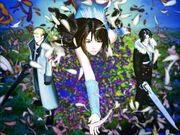
Seifer, Rinoa and Squall.
Squall Leonhart is opposed by his arch-rival Seifer Almasy. Squall wears a short black jacket and while Seifer's is long and white. The two use gunblades to battle, each having their own preferred model and fighting style, Seifer's being dark in color and Squall's being light. The both had the same love interest, and whereas Squall ends up leading the SeeDs in a battle against a sorceress, Seifer leads the G-Army to oppose him.
Likewise, the love interest of Squall, Rinoa Heartilly, is contrasted with the main antagonist, Ultimecia. Both are extremely powerful sorceresses; one easy-going and innocent while the other is cruel and heartless. Rinoa is symbolized as an angel with many references to angels ranging from her dog, Angelo, to the pattern of white wings on the back of her duster. Ultimecia on the other hand sports black wings and even has her own Griever, an evil leonine being, on her side. Her hairstyle gives her the appearance of having the devil's horns contrasting with Rinoa's angel imagery. Rinoa is characterized by the blue of her duster, the black of her hair and the rest of her clothing, and the white of her angel wings. Ultimecia's color scheme is the opposite: she has a red dress, white hair and black wings.
Final Fantasy IX
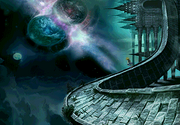
The merge of Gaia and Terra.
There are two worlds: Gaia and Terra. The Terran world was destroyed millennia ago so its people attempted to assimilate Gaia by sealing themselves in sleep and gradually replacing the souls of Gaia with those of Terra's. To assist them, the villain Kuja was created as an "Angel of Death" to incite death and war on Gaia and speed up the process. Later, a second Angel, Zidane Tribal, was created, the main protagonist.
The contrast between Terra, the dying world seeking to rejuvenate, and Gaia, the living world that is slowly dying due to losing its souls, is shown with the colors red and blue. Terra is the red world, its crystal shining red, which also gives the color to Gaia's second moon, the one originating from Terra. Thousands of years ago, when Terra attempted to absorb Gaia's crystal, the Fusion process failed and Terra shifted to the inside of the planet of Gaia its moon moving onto Gaia's orbit giving the planet two moons: the blue moon of Gaia and the red moon of Terra. The Final Fantasy IX Ultimania mentions that when the moons' orbs overlap and the blue moon of Gaia eclipses the red moon of Terra, the red moon is hidden from view entirely due to its dimmed glow from Terra's weak crystal. When the red moon eclipses the blue it gains a blue aura.[1] This may symbolize Gaia having dominated the attempted merge of the two worlds, hiding Terra from view.
In Crystal World, the crystal from which all worlds are born from is surrounded by two streams of light: one blue, one red. At the end of the ending credits the two moons appear to merge and become one, seemingly transforming into the crystal that is the logo for Final Fantasy IX .
.
Final Fantasy X
The monster Sin was created by Yu Yevon to destroy any machina-based settlement that grew too large. A summoner is able to hold off this destruction by summoning the Final Aeon to destroy Sin. When this happens, the spirit of Yu Yevon within Sin possess that aeon, transforming it into a new Sin and continuing an endless cycle. When Summoner Yuna and her guardians kill Yu Yevon, she ends the cycle and destroys Sin for good. However, in the process, the world that had been dreamed up by the fayth is also destroyed, causing Tidus to disappear.
The corporeal world and the spirit world are thus juxtaposed. The spirit world is represented by Tidus's Zanarkand and the Farplane, as well as the fayth and the aeons, the unsent, and even some fiends. The corporeal world of Spira is where mankind makes its living. Multiple characters breach the gap between the two; namely, the ones who become unsent, and Tidus who is a dream of the fayth yet finds his way to Spira.
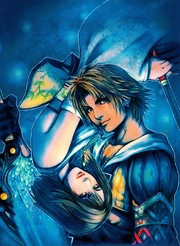
Artwork of Yuna and Tidus is a yin and yang juxtaposition.
Yuna's and Tidus's characters may allude to the Chinese concept of the yin and yang. In Chinese philosophy, yin and yang are concepts used to describe how apparently opposite or contrary forces are actually complementary, interconnected, and interdependent, giving rise to each other as they interrelate. Many tangible dualities (such as light and dark, fire and water, and male and female) are thought of as physical manifestations of the duality of yin and yang.
Yin is the negative/passive/female principle in nature, and may allude to many other concepts e.g. the moon, shaded orientation, something covert or concealed, "of the netherworld", overcast or sinister. Yang is the positive/active/male principle in nature, and may allude to many other concepts e.g. the sun, open, overt, and "belonging to this world". This could be represented by Yuna's readiness to die to complete the Final Summoning, and thus others treating her thusly. Tidus on the other hand is full of life and wants to find a way to save Yuna, though in the end he is the one to fade away. The sun and the moon themes are represented in the couple's names and the crests needed to empower their Celestial Weapons.
Yuna and Seymour Guado also parallel one another. Both are biracial and have a parent who sacrifices themselves to defeat Sin. Whereas Yuna's biracial heritage is not readily apparent and she is accepted into society, growing up in a loving and supportive environment, Seymour grows up in a hostile environment and adopts a negative view of life, becoming nihilistic. Both become summoners, but whereas Yuna's goal is to defeat Sin for good to end Spira's suffering, Seymour seeks the same goal by trying to become Sin himself and destroy Spira. Both Yuna and Seymour display aspects of Jesus Christ: Yuna is willing to die to defeat Sin, and in one scene she walks on water when performing the sending, a ritual that "saves the souls of the dead" by sending them to the Farplane; when Seymour is killed he assumes the pose Jesus is often depicted on the cross, and soon "rises from the dead" by becoming an unsent.
Final Fantasy X-2
The concept of dualism is present in the form of Yuna and Shuyin: Yuna is a human seeking for her lost lover while also being a witness of new Spira rising, Shuyin is an unsent wishing to destroy Spira as his grief and anger to avenge his lover's death.
Final Fantasy XI
The enlightened races—those races believed to have been created by Altana, the Dawn Goddess, a good deity—face off against the hordes of beastmen—races created by Promathia, the Twilight God, who is twisted and evil—on Vana'diel.
Final Fantasy XII
The conflict between despotism and self-management is represented in two aspects: the main characters witness the rise of the Archadian Empire and its conquering of the Kingdom of Dalmasca, and sequentially ally themselves with the Resistance force against Archadia.
The main antagonists' also seek to free mankind from the divine control of the undying Occuria—who intervene in its history—and give mankind their own means, which are comparable to the gods', to craft its future. Archadia acts as social commentary on democracy and gives the Occurian rule some credibility as demonstrated through the constant power struggles. Vayne has arguably noble intentions of wishing for humanity's future to be governed by man, but in his actions, he is replacing one dictator with another. Vayne loses sight of his original goals in his madness, shown by disregarding his younger brother's counsel and fighting him. In the end both the Occuria's and Vayne's oppressive means of autocracy are ended by the heroes, implying a new dawn free from dictatorship is at hand.
Final Fantasy XIII
The two lands of floating Cocoon and the lowerlands of Gran Pulse, two separate worlds that both view the other as corrupt or evil plays on the dualist theme. Additionally the roles of fal'Cie and humanity on each world is also reversed in that on Cocoon, humanity relies upon the fal'Cie for survival, while on Pulse the fal'Cie are almost indifferent.
Final Fantasy XIII-2
During the events of the sequel, there are still two worlds, but with a different dualism approach: the passage of time. While Gran Pulse and Cocoon are in constant movement with time paradox appearing within their timelines, Valhalla is a place where past, present, and future intersect, meaning that time doesn't flow "as it should" there. Another, plainer example of dualism are the characters Lightning and Caius, whose goals are complete opposites: Lightning wants to save the goddess Etro and protect the world, while Caius wants to kill Etro and trigger the apocalypse.
Lightning Returns: Final Fantasy XIII
The two worlds of the previous games have been mixed together into the world of Nova Chrysalia, which itself is violently divided: two of its four landmasses are populated cities, while the other two are wild, untamed and mostly uninhabited. The continents themselves are also opposites of each other; while Luxerion is a religious capital of prayer and Yusnaan is a pleasure city where the inhabitants enjoy their days to the full, while the Dead Dunes are comprised of rolling dunes and ruins and the Wildlands are covered in forests and vegetation. The color themes of black and white are apparent throughout the artistic style of Nova Chrysalia, representing Lightning and Bhunivelze respectively.
Final Fantasy XIV
The world of Hydaelyn has constantly undergone periods of abundance, known as Astral Eras, followed by catastrophes that bring scarcity and can destroy entire civilizations. These are known as the Umbral Eras. At the start of A Realm Reborn, Hydaelyn is in its Seventh Umbral Era.
Final Fantasy XV
The world is contrasted between modern elements and magical elements, such as Crystals and Astrals, and the modern nation of Lucis and the "fantasy kingdom" of Tenebrae. The Niflheim Empire seeks a magical power as well to rival Lucis, but gains power through magitek from daemons instead, the antithesis to the power of the Crystal.

Forces of light and darkness pulling Noctis and Luna apart.
Playing on the dualism theme, Noctis Lucis Caelum and Lunafreya Nox Fleuret (dressed in black and white respectively), hail from the kingdoms of Lucis ("Light") and Tenebrae ("Darkness"). Luna, whose name mean "moon" in Latin, is an Oracle who keeps the darkness of he Starscourge at bay with her powers, stopping the world from being swallowed in an eternal night, similar to how the moon offers a point of illumination in an otherwise dark night. Noctis's name is the genitive singular form of the Latin word nox meaning "night".
The darkness and light theme extends to the concepts of life and death. Lucis's emblem is a winged skull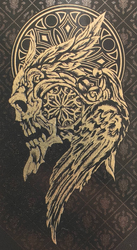 , and the nation was said to openly worship figures of death in the old concepts when the game was known as Final Fantasy Versus XIII: this concept remained though its overt expression was reduced.[2] The revering of death remains as a theme, with the past kings lending their powers to their ancestors, and the royal tombs being places opened for the current king to receive this blessing from the dead. In juxtaposition, Niflheim also gains power from death in the form of daemons, but this is a dark power that at least in Ardyn Izunia's case prevents one's ascend to the afterlife. The Ring of the Lucii, a Lucian royal heirloom, gains power through death as the Crystal's power is transferred into it when the ring-bearing king dies. The True King can restore light to the world by sacrificing his own life.
, and the nation was said to openly worship figures of death in the old concepts when the game was known as Final Fantasy Versus XIII: this concept remained though its overt expression was reduced.[2] The revering of death remains as a theme, with the past kings lending their powers to their ancestors, and the royal tombs being places opened for the current king to receive this blessing from the dead. In juxtaposition, Niflheim also gains power from death in the form of daemons, but this is a dark power that at least in Ardyn Izunia's case prevents one's ascend to the afterlife. The Ring of the Lucii, a Lucian royal heirloom, gains power through death as the Crystal's power is transferred into it when the ring-bearing king dies. The True King can restore light to the world by sacrificing his own life.
The powers of light and dark, and life and death, are represented as the Crystal and the daemons and the plague that plunges the world into perpetual darkness: Starscourge. The Crystal is said to hold the soul of the world of Eos, the world's name itself referring to the theme of light and dark: in Greek mythology, Eos is a Titaness and the goddess of the dawn. The Oracle uses their powers to extend the life of the world and its people by keeping the Starscourge at bay, while the King of Lucis must use their own life force to wield the Ring of the Lucii.
The high-ranking Niflheim officials dress in white, whereas Lucians dress in black. Ardyn Izunia's attire uses both colors, and in many ways exists as juxtaposition to Noctis. When Ardyn uses powers similar to Noctis's, he glows red as opposed to Noctis's blue. He represents the forces of darkness where as Noctis is the King of Light. Ardyn is unable to truly die and enter the afterlife, whereas Noctis must sacrifice himself to free the world of Ardyn's influence. Angel and demon imagery is part of this, the evil and darkness being represented by daemons, whereas divinity is associated with angels and angel wings, as with the Messengers, the Oracle and the motifs on royal arms. The angel and demon juxtaposition can also be seen with Ravus and his sister Lunafreya, the latter being depicted with an angel wing in the logo and in the painting of the prophecy, and Ravus who ends up turning.

Pryna and Umbra.
Lunafreya's magical Messenger dogs, the black Umbra and the white Pryna, also refer to the light and dark dualism theme. Whereas Umbra is associated with a corporeal presence, delivering physical messages between Noctis and Lunafreya and literally transporting the player to return to past areas of the game, Pryna is associated with dreams and visions. Pryna and Umbra, as well as Lunafreya and Noctis, could be likened to yin and yang from Chinese philosophy, where here yin is the negative/passive/female principle associated with the moon, shaded orientation, and hidden and sinister and overcast things, and yang is the positive/active/male principle in nature, also representing the sun, openness and "belonging to this world". Yin is represented by black whereas Yang is represented by the color white, but the light/dark dualism is represented as inverted in Final Fantasy XV, also seen with the colors of the Crystal, Lucis, Tenebrae and the Niflheim Empire.
Etymology
Dualism (from the Latin word duo meaning "two") refers to the state of two parts.
References
- ↑ World Establishment (development materials) continued – p. 43 of the FFIX Ultimania (Accessed: UnknownError: See this for how to archive.) at Lifestream
- ↑ Why Noctis and his companions are dressed in black? Hajime Tabata's answer (Accessed: UnknownError: See this for how to archive.) at Official Final Fantasy XV Forums
